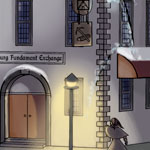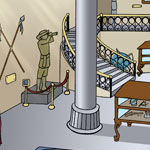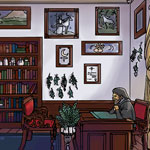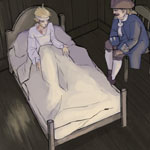Aradie's Institutions

Fundament Exchange
The meaning of fundament here is raw ore extracted from the ground. The exchange is owned by the Aradie Trading Company, whose royal charter requires all ore found in the colony to be sold to them. To leverage this section of the charter, the company established the exchange to weigh any ore brought in from the wilderness and to pay the miners. The rates are set by royal decree and are subject to heavily politicking between the miners and the company. There is a healthy black market in Sherbourg for miners to sell ore to parties other than the Aradie Trading Company.
Prospectors have not found the vast quantities of gold that are pouring out of Ilandria's colonies in Ascuta. Instead, the Aradian miners have made do with high-quality copper and some silver. The natives of Everique have little interest in toiling in the mines, and the colony is dependent upon good relations with the tribes to keep the furs flowing from the west. There are not enough miners among the colonists to expand beyond the small excavations scattered through the Trablais Mountains. This is not enough to support a robust colony, so the focus of the colony remains on the fur trade.
The Fundament Exchange holds the greatest concentration of wealth in the town, but it is mostly in the form of unprocessed ore, which is cumbersome to steal. During the summer months, the company's ore is smelted into ingots for transport to Saronne. Each ingot is stamped with the seal of the Aradie Trading Company. Possession of a ingot without the papers recording the purchase of the ingot is a high crime.

Museum of Sherbourg
The Museum of Sherbourg is a fairly recent addition to the city. It is the brainchild of Antoine Dupuis, its founder and curator, whose purpose was to display many of the fascinating plant samples that he was collecting from across Everique. However, the museum is primarily known for its collection of native artifacts, which is the largest and most impressive in the colonies and rivals museums in Japethe. The museum is housed in a three-story building adjacent to the University of Sherbourg in Templetown. The building boasts an elliptical grand stairway that runs the height of the building.
The Museum of Sherbourg has a collection of native artifacts that is disproportionately large for a museum of its age and number of patrons. The core of the exhibit began with war trophies brought back by the Salores Regiment in its attack on the Liranequois in the First Pelt Wars. The museum has steadily added to the collection over the years. One of the primary contributors to the museum is Cienan yr Tuathal, who has donated both financial support and rare pieces for display. Many of the tribes are ill-disposed to having artifacts of their culture on display in museum. The museum will sometimes return pieces to friendly tribes who are allied to Saronne. However, the museum has steadfastly retained the artifacts captured from the Liranequois as well as any found from the vanished Odaeneois.

University of Sherbourg
The University of Sherbourg is the only institution of higher learning in Sherbourg. Founded in 1570 by Hélène de Montegny, the first Oracle of Giavere in Sherbourg. The University is an outgrowth of the Seminary of Giavere, where the seers of the Great Spirit are trained. The primary purpose of the University, as stated by the charter granted by the High Oracle of Arcaneaux, is the study of flora and fauna of newly discovered Everique.
Using the term university for this institution is an exaggeration of its capacity. The University has nine philosophers in residence and less than 100 students, most of whom are seers in the service of Giavere. If it weren't receiving support from the temple, the University would have folded decades ago.
The University is located in Templetown in the Upper City of Sherbourg and is housed in a single four-story building with classrooms on the ground floor, libraries and reference materials on the second floor, offices on the third floor, and dormitories on the fourth. Most of the rooms are small to make heating easier. Even the libraries are series of interconnected small chambers. The large classrooms are notoriously cold, where both students and professors huddle in thick academic robes, and the students sometimes have issues with their ink freezing.

Vignerot Hospital
Vignerot Hospital is an imposing four-story stone building in the Templetown district of Sherbourg. The building stands atop Cape Adamant, giving it a sweeping view of the Grand Vire. The fresh breezes carried in by the river are crucial to the health of those within. The hospital has more than 40 beds and is staffed by a dozen nurses, five medical philosophers, and two apothecaries. The hospital is free to all in need, as it supported by the largest seigneurie in the colony. Wealthy patients are heavily encouraged to make donations to support the hospitals' work.
The Seers of Giavere founded the hospital in 1573 after they were given a generous gift by Duchess Madeleine Vignerot, the niece of King Marcelet III. It was originally a tiny wooden structure, protected by a wooden palisade. The hospital was brought inside the walls of Sherbourg during the First Pelt War as the Liranequois regularly burned the outlying buildings. The hospital was rebuilt in stone after the fire of 1616.
The healers at Vignerot Hospital wage a prolonged war with the pestilence brought by the various malignant spirits of disease that make their way to Sherbourg. Plagues were regular and virulent in the early years of the colony when the port town of Sherbourg acted as a trading post with the native tribes of Everique. The malignant spirits were horrifically active during this period, causing havoc and death among the native allies of the fledgling colony.
The most renowned healers at the hospital were a married couple: Anne-Marie, a seer of Giavere, and Michel Sazarrin, a medical philosopher. Together, they struggled to contain the terrifying malignant spirit that caused the smallpox epidemic of 1612. Both died from the disease, still tending to the other patients of the disease. Their statues stand at the gates of the hospital, erected by a grateful populace.
Since the focus of the fur trade has shifted to Ville Marcelet, the hospital serves less of the native population than it did. Its focus has shifted to serving the settling colonists and visiting sailors. One entire wing of the hospital has been set aside to quarantine sick sailors.
« Return to the Almanac Index

